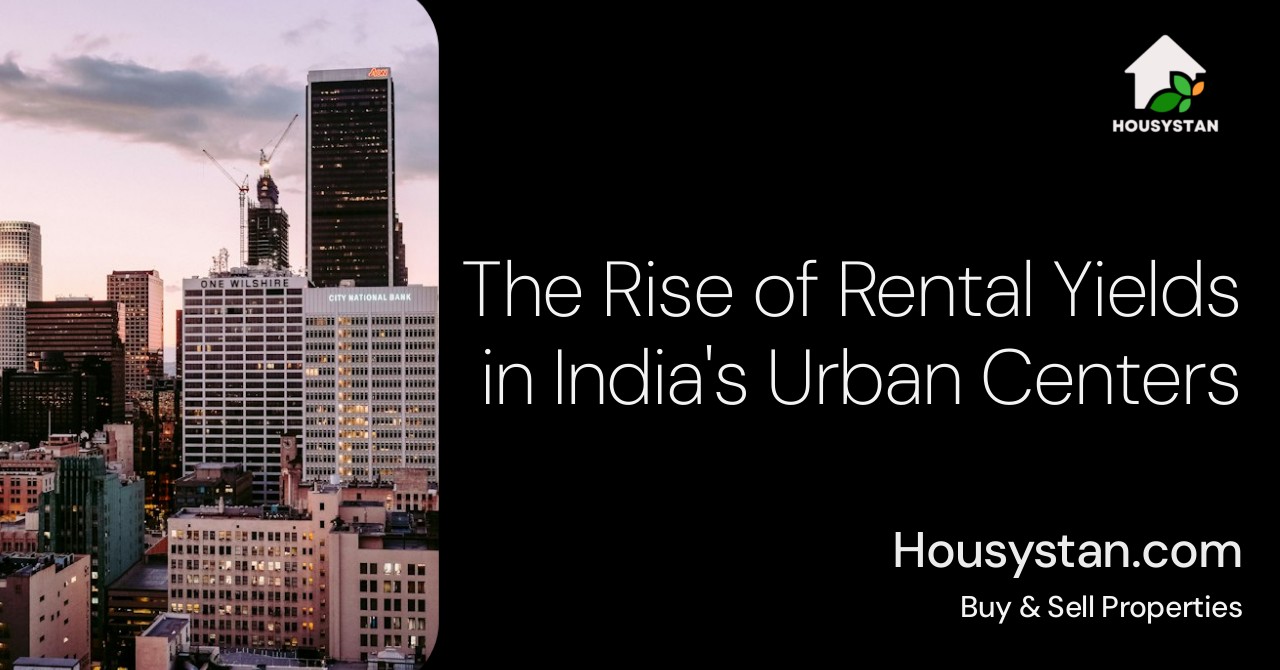The Rise of Rental Yields in India's Urban Centers
Read latest blogs and articles from Housystan

The Information mentioned here was last updated on:
27/11/2025The Rise of Rental Yields in India's Urban Centers
India's urban landscape is changing rapidly, and with it, the dynamics of the real estate market. One significant trend gaining traction is the rise of rental yields in key urban centers across the country. This shift is not only impacting property investors but also tenants and city dwellers who are navigating the ever-evolving urban environment.
Understanding Rental Yields
- Verified Tenants/Buyers
- Unlimited Property Listing
- Zero subscription/charges fee
Before diving into the factors driving the increase, it’s essential to understand what rental yields are. Simply put, rental yield is a measure of the rental income generated by a property as a percentage of its market value. It serves as an indicator of the return on investment (ROI) for property owners.
How to Calculate Rental Yields
Calculating rental yield can seem daunting, but it’s relatively straightforward:
1. Gross Rental Yield: This is calculated before deducting expenses.
- Formula: (Annual Rental Income / Property Value) x 100
2. Net Rental Yield: This accounts for expenses related to managing and maintaining the property.
- Formula: [(Annual Rental Income - Annual Expenses) / Property Value] x 100
Higher yields typically suggest a more lucrative investment, attracting more investors to the market.
Key Drivers of Rising Rental Yields
The increase in rental yields in India’s urban centers is driven by several factors:
Rapid Urbanization
- Population Growth: India's cities are experiencing significant population increases, driven by both natural growth and migration from rural areas.
- Economic Opportunities: Urban centers like Mumbai, Bengaluru, and Hyderabad offer better employment prospects, drawing more people to these regions.
Growing Demand for Rental Properties
- Affordability Issues: With property prices continuing to soar, buying homes remains out of reach for many, boosting the rental market.
- Lifestyle Changes: Younger professionals prefer the flexibility of renting homes, avoiding long-term commitments associated with buying property.
Infrastructure Development
- Improved Connectivity: New roads, metros, and other transport facilities make urban centers more accessible, increasing their appeal.
- Smart City Initiatives: Urban renewal projects and the development of smart cities are enhancing the quality of living, thus attracting more residents.
Policy Reforms
- Ease of Doing Business: Government policies aimed at simplifying property regulations and lowering taxes have enticed more investments.
- Housing Schemes: Initiatives like the Pradhan Mantri Awas Yojana aim to make housing more accessible, indirectly supporting rental markets.
Leading Cities Witnessing a Surge
Several urban centers in India are spearheading the rise in rental yields:
Bengaluru
- Known as the Silicon Valley of India, Bengaluru has a booming tech industry.
- The influx of IT professionals leads to high demand for residential rentals, pushing up yields.
Mumbai
- Despite its high property prices, Mumbai remains an attractive location due to its status as India’s financial capital.
- The continuous demand for housing ensures substantial rental returns.
Hyderabad
- Rapid IT sector growth and competitive property prices make Hyderabad a hotspot.
- Infrastructure improvements boost the real estate market, enhancing rental yields.
Pune
- Proximity to Mumbai and its burgeoning educational institutions attract students and professionals, maintaining consistent rental demand.
- As a thriving industrial and educational hub, Pune attracts diverse demographics, ensuring robust rental markets.
Tips for Investors Looking at India's Rental Market
Investing in the rental market requires careful consideration. Here are some tips:
- Research Thoroughly: Before investing, understand the local market conditions and future growth prospects.
- Location Matters: Choose locations with high demand and potential for appreciation.
- Assess the Amenities: Properties near schools, offices, and recreational areas tend to attract more tenants.
- Understand Legal Aspects: Familiarize yourself with local laws affecting landlords and tenants to avoid any legal hassles.
Challenges to Consider
While the rental market offers lucrative opportunities, it also presents challenges:
Fluctuating Market Conditions
- Economic downturns can reduce rental demand, affecting yields.
- Over-supply of properties in certain locations can lead to lower rental prices.
Regulatory Hurdles
- New regulations can impact rental agreements and tax liabilities for property owners.
Maintenance and Management
- The cost and effort to maintain properties can impact net yields.
- Managing tenant relationships requires time and resources.
The Future of Rental Yields in India
Projections for the future of rental yields hold promise:
- Continued urbanization and infrastructure advancement are likely to sustain rental market growth.
- The rise of co-living spaces and shared accommodation may transform the traditional rental market, impacting yields positively.
- Integration of technology in real estate through PropTech innovations can enhance property management efficiency, optimizing rental income.
Bridging to Broader Trends in Real Estate
As rental yields in urban centers rise, they offer a glimpse into broader trends in the Indian real estate sector:
- Shift Towards Sustainable Living: Green buildings and eco-friendly practices are becoming appealing to both investors and tenants.
- Role of Digital Platforms: Online platforms are making property management and tenant acquisition more streamlined.
- Integration with Technology: IoT and smart home features could become standard, enhancing property appeal and potentially increasing rental yields further.
The interplay of these factors points to a dynamic future for India’s urban rental market as it adapts to changing societal and economic conditions. While the journey is not without its complexities, the prospects for growth and innovation are encouraging, setting the stage for a vibrant real estate landscape.
For more insights into real estate dynamics, readers might explore related topics such as the impact of digital transformation in real estate or the evolution of smart cities in India.